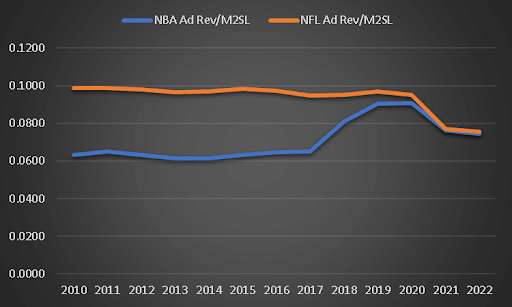Author Disclaimer: The following work is a combination of real world commentary and fan fiction, similar to your favorite sci-fi world. I do not intend to infringe or misappropriate any real world ideas or work. Any similarity to concepts or work in the fan fiction portion that I do not explicitly reference is purely coincidental. This is Part 3 of a series I call “Bitcoin: What-If?”. Marvel can’t own that, right?
What If… Professional Sports
Have you questioned or heard someone question why professional athletes make so much money? It’s a fair assessment of a fairly new phenomenon as salaries for athletes have ballooned. The below average journeyman of today would earn double of a hall-of-fame caliber player from the 90s. There is some irrationality to that dynamic, even if we thought inflation was a normal and healthy feature in society.
There is a cadre of bitcoiners that would dismiss “sportsball” as irrelevant to society. I would argue that like nearly everything in the world, the sports economy is adversely affected by Keynesian fiat mechanisms. The root of these problems in our world often go unconfronted because of the conveniently camouflaged issues. To fix the money is to bring sports and its economy back to its proof-of-work foundational principles.
As bystanders, are we to casually accept that 9 of 10 highest salary earners in the history of NFL all played as recently as 2019 (excluding Peyton Manning)? Should we consider it commonplace that the top 12 players in all time guaranteed compensation in the NBA are all active (with Kevin Garnett being the 13th). Power to individuals being compensated for their efforts, I celebrate talented performers being rewarded for their sacrifice and risk. Pleading to a rational construct of compensation, all things considered equal, the best players should generally receive the best pay across time and space. Assuming one accepts a gradual expansion of the money supply, you can explain a slight uptick in compensation in all professions, both standard and exotic. Your pay increases by 3%, so does your favorite football team’s salary cap. But how about when your pay continues to increase by 3% annually, but your team’s salary cap increases by 20%, then 20% the next year. Something happened, and it’s confusing because there is no flag raised by trusted media sources so no public reaction. It seems to be normal.
The table below exhibits the advertising revenue reported by the NBA and NFL. Listed along these numbers is the M2SL, which most closely tracks monetary expansion.
|
Year |
NBA Ad Rev ($M) |
NFL Ad Rev ($M) |
M2SL ($B) |
|
2022 |
1600 |
1620 |
21490.1 |
|
2021 |
1460 |
1470 |
19124.7 |
|
2020 |
1390 |
1459 |
15319.1 |
|
2019 |
1298 |
1390 |
14358.8 |
|
2018 |
1120 |
1320 |
13853.3 |
|
2017 |
861 |
1250 |
13209.6 |
|
2016 |
799 |
1200 |
12344 |
|
2015 |
739 |
1150 |
11681.5 |
|
2014 |
679 |
1070 |
11028.8 |
|
2013 |
642 |
1010 |
10459.7 |
|
2012 |
610 |
946 |
9660.1 |
|
2011 |
572 |
870 |
8801.8 |
|
2010 |
536 |
8496 |
Sources:
- https://www.statista.com/statistics/380270/nba-sponsorship-revenue/
- https://www.statista.com/statistics/456355/nfl-league-team-sponsorship-revenue-worldwide/
Plotting these numbers annually produces a metric that would be expected from successful industries. It is commonly accepted that the NBA and NFL are performing exceptionally due to this revenue growth.


When normalizing these revenue numbers against the M2SL it paints a different picture. This metric describes their respective share of the expanding economy. Over this 12 year period, these leagues actually only keep pace with the economy as opposed to true growth.
Besides the fraudulent framing of success as a factor of growth, to keep pace with an artificially expanding economy is not inherently bad. What is bad is when an entity experiences asymmetric benefit from money printing. This is known as the Cantillon Effect and it is never more evident than how major professional sports leagues maintain their wealth. Take a look at the diagram below.

The diagram seeks to exhibit the closely related (incestuous?) money flow amongst these entities with close proximity to the money printing. When money is created out of thin air to sustain the economy, like a champagne fountain, the spillage or subsidies is abundant for the entities with very few degrees of separation. Athletes are paid by teams in sports leagues with lucrative television deals that are owned by mega media corporations funded by asset management firms that are given the same advantages as commercial banks and financial institutions by the Central Banks. As the money expands, these entities are benefactors of the new money supply to spend before common economic participants ever see it. This is how inflation hurts society. The elite that normies subscribe to for their “expert” opinions will never acknowledge this because they always front-run the negative effects.
Asset management firms, especially Blackrock, Vanguard, and State Street, have a strikingly large stake in the visual content consumed in America. The growth of these institutions has been aided directly by the entity that prints money. Because of the asymmetric benefit of money printing, the incentives, values, and ethics of the benefactors of this formula rise to prominence.

As humans, we value the knowledge of an event as near real time as possible. This is virtually a universal trait so it is hard to argue it is groomed. No media product carries the same real time novelty as a sporting event. There is minimal staging, maximum conflict, morally neutral, and every episode/event maximally unique. This is a formula for the last bastion of real time advertising in a world of streaming and ad skipping. The elite understand that eyes and ears are tuned to the big sports event, and they count every second they can get to sell to you.
“You” is not of course universal. The Austrian understands “you” as the atomic individual. However, in our Keynesian world, unique individuals are thrown in the mixer of skewed empiricism for the sake of the “greater good”, “general audience”, or “majority”. In other words, your existence to the people that have mastered crony capitalism is little more than a binary switch: reach out or discard.
Consumerism is higher among urban populations as discussed in a past article of mine. If a company has 30 seconds to sell something, they will use tactics to not only to convince you they are aligned with your wants/needs/views, but will also attempt to realign what your wants/needs/views are to make you a more cooperative consumer. This concept is known as “social proof” and is captured in the book Influence by Dr. Robert Caldhani.
The principle of social proof states that one important means people use to decide what to believe or how to act in a situation is to examine what others are believing or doing there. Powerful such effects have been found among both children and adults and in such diverse activities as purchase decisions, charity donations, and phobia remission. The principle of social proof can be used to stimulate a person’s compliance with a request by communicating that many other individuals (the more, the better) are or have been complying with it. Therefore, simply pointing to the popularity of an item elevates its popularity.
There is nothing inherently wrong with an aggressive marketing campaign. The violation comes from the infinite Cantillon Effect information chain where the ability to propagate a message is as long as the money printer can produce fiat.
Don’t really care about that bland corporate beer? You will see models drinking without you until you like it. Do you like using cash too much? Zelle will convince you cash sucks. In need of encouragement to throw your earnings away in a Ponzi scheme? Shaq and Steph Curry will compare Bitcoin mining to a block of ice as they convince you FTX is the place to trade crypto safely. Have you not turned into your fossil fuel vehicle yet? Chevy will bombard you with rapid images of EV charger clicks and people smiling at every sports TV timeout.
Our financial system enables advertisement to be a war of attrition. As long as a company can create enough noise or distraction, they can overwhelm even the most stoic sensibilities. Because these Cantillon institutions have essentially endless funds (as vassals of the central bank), they do win as a function of time viewed.
Campaigns to increase viewership provide more avenues to access a person’s attention and savings. These pull marketing strategies are intermixed across commercials, social media, and staged organic signals to encourage you to consume something you did not intend.
If the NBA is in the offseason for 4 months, can ESPN and the NBA determine a way to monetize that opportunity? Look no further than the WNBA. Rather than appeal to the product’s value, the appeal is directed at the legitimacy consumers’ values. Using politics as a form of interest, the product is aligned with topics that traditionally we’re what sports were used to escape.
Aligning with social issues creates interest albeit not for the purpose of putting a ball in a basket. For the normie, it’s another reason to fight amongst one another. For the Cantillon elite, they have bought another 4 months of some viewers of their advertisements so they can regurgitate from the men’s playoffs in the spring for minimal cost to them. Based on the co-branding from major for-profit companies, some of them even too big to fail, it is clear that preferred politics is reason enough to fund a product in this fiat world; even if the quality of product does not warrant. After all, the “social” in ESG earns credit as well.
While these concerns are all in need of addressing, they are social or psychological issues. What does Bitcoin have to do with sports and marketing? In one word…everything.
It Is Sometime In The 2090s…
In this future, there is hope. In this future, humanity prospers. Fiat money has capitulated to Bitcoin, the decentralized monetary network, and has consumed nearly all value of the world’s fiat wealth. Through years of violent volatile trading with world governments being public buyers, bitcoin surged through bull and bear markets whose end was only marked by the 2033 Bitcoin International Treaty (B.I.T.) to dismantle central banks across the world for the sake of a new Bitcoin Monetary Standard; 100 years after Executive Order 6102 that forbade the individual ownership of gold by U.S. citizens for a period of time. Nearly all governments in North America, Europe, South America, South Asia, Middle East and Africa came to adopt Bitcoin-backed regional digital tokens (dollar, euro, peso, rupee, dinar, franc). These currencies had centralized oversight and insurance that was more palatable to a segment of the population. But because no one was forced to use it, the free market of value exchange thrived with bitcoin as the dominant unit.
Some countries in Oceania and Asia remain obstinate to a hard money supply like China and Australia. They did not participate in B.I.T. and outlawed owning any alternate currency or token, especially bitcoin. Instead they chose the path of surveilled and coercive CBDCs as they continued to slowly steal the wealth of their constituents. CBDC implementation was made easier upon outlawing emigration decades before as citizens of some countries became essentially prisoners. People in those regions essentially became pawns of a machine and lost nearly all evidence of individualism.
Because the Bitcoin world virtually ceased currency inflation, the exchange rate of 1 BTC steadied at about $25 million USD. Human innovation and advancement gradually increased the purchasing power of all people in the free world as technology drove asset deflation. In a world where very few remember a time without hard, unconfiscatable money, the incentives surrounding the sports industry have evolved in ways that would be peculiar in 2022.
Sports Media Disrupted
Major media rights deals became less prominent near the beginning of the 22nd Century. The advancement of virtual reality video capture enables any number of people to sell their experience at the stadium with wearable environment recording solutions. What was initially not allowed in stadiums because of the size of equipment became impossible to police as VR camera sets became a combination of discrete eyeglasses and pearl-like earrings. Pursuing VR capturers (aka “VRaptors”) after publishing was not possible because NakaVision, the Lightning-based decentralized social streaming service, could not centrally censor; individuals could only mute or block.
Using collaborative virtual environment creators, a network of a few VRaptors could walk around for a half hour and map out the entire stadium (with the help of some simple AI) for a completely immersive experience for a subscriber. Even once the game starts, the VRaptors sitting or patrolling different areas of the stadium provide the virtual attendee to teleport to any number of places in the stadium to catch the angles they want when they want. Using a podcast streaming plugin, the VR stadium could pump in the audio of your favorite unaffiliated commentators to get a custom game.
Of course, the media company could do this very thing and likely better. The 3rd party product was so similar to the official product that subscribers naturally drifted away from mainstream services. Listening to commentators free from corporate ads became a standard as people grew to accept paid services. Some VR experiences for an extra price were willing to white out in-stadium ads.
Institutional Money Reduces
The large investment firms that were the source of the gravy train in the “Peak Fiat Years” of the 2020s took a massive step back from funding mainstream sports. Firstmost, major media companies were not able to capture a massive segment of the audience as mentioned above due to the inability to contain VRaptor experience architects. Without the captured attention of the viewers, there was no point to pursue corporate advertising with a select few entities in decades past. Partnerships were dissolved and the guaranteed money from them did too.
This caused a massive reduction in revenue for leagues and consequently players salaries. Players associations even put out multi-year ad campaigns discouraging the use and consumption of independent VR experiences in the 2070s. Their plea fell mostly on deaf ears because there was not much rationale except to protect their lucrative contracts. Technology, in a similar way as a civilian with a semi-automatic rifle, became a “force-equalizer” against those that would use monopolies over communication to extort value rather than create it.
Risk Of Not Creating Value Returned
Risk became a concern again in investing, especially with those with much to lose. Funding was no longer a Cantillionaire political game of being the best friends with a Fed governor. Any borrowed money had to outperform the interest rates that were now completely determined by the free market. In the early years of the BIT, there were some entities that did not realize how quickly money would dry up without a bottom line that was “in the black” when there was no more “lender of last resort”. Five years into the BIT, 95% of silicon valley was out of business. The old growth strategy of prioritizing investors funding over creating value for consumers could not work when everyone in the world knew new money could not be created.
“Just Win Baby”
It was over 105 years ago, January 1984 to be precise, when the Los Angeles Raiders defeated the Washington Redskins in Superbowl XVIII. Team owner, Al Davis, gave the short, powerful quote “Just Win, Baby” to claim emotional victory over league commissioner, Pete Rozelle, from a multiyear political battle of Davis’ intent and action of moving the team away from Oakland two years prior. Regardless of politics, corporate nepotism, and cronyism surrounding sports, Al Davis produced a team that focused on the root objective of the game: “a commitment to excellence” and winning.
Because of the apolitical nature of Bitcoin, there was very little room for sports organizations to focus on anything else other than a product that performed and a consumer base that would pay for and attend games. While those two factors were generally correlated, major metropolitan areas showed trends of greater disinterest during bad seasons. In the fiat past, this was hardly a concern due to TV deals and endless marketing that created enough fanatical devotees and passive revenue for even historically poor teams to thrive. When easy corporate funding dries up, priorities for business ventures quickly change. Middle-sized cities exhibited considerably more financial success with professional teams like Tampa and Pittsburgh. When the New York Jets moved to Richmond, VA in 2038, they became remarkably more profitable than the decades living in the shadow of the Football Giants. This sparked a trend of professional sports teams migrating to untapped domains. The Oakland Athletics moved to Boise, ID in 2040. The Atlanta Hawks moved to Lincoln, NE in 2041. Several other teams in the big four leagues followed suit in the coming decades. This resulted in professional sports leagues changing their strategic engagement to more appeal to suburban and rural consumers. This was nearly non-existent before the BIT. The political values of these leagues became less polarized over time and sought to maximize their profitability through finding willing consumers rather than virtue sympathizing with powerful social influence.
Did Bitcoin Fix or Fail Sports?
Hard money brought clarity back to the objective of sports: to win and to entertain. This clarity also impacted the end consumer and investor. It was simply harder to separate them from their money which led to reduced revenue for sports leagues and consequently teams, then players.
Revenue sharing became a contention point with owners of bigger markets. A once acceptable standard of socialism when money was easy quickly became a pain point when tomorrow’s earnings were scarce. While this factored in teams moving away from cities that were not profitable, it also caused some franchises to make even more drastic changes. Low local demand was bad for profitability and teams needed to move where they could survive.
- Six MLB teams closed operations permanently. Six NBA teams left the NBA to form an international league with 18 other teams around the world.
- The entirety of the NHL joined with the leagues in Finland, Sweden, and Russia to make a shortened regular season, a super postseason structure, and even some limited interleague play.
- The NFL moved 25% of its teams to Europe creating AFC Euro and NFC Euro divisions.
While these changes did well to create more demand and intrigue, it still could not return any of these leagues to their lucrative “Peak Fiat Years”. Team ownership was more transitory than before. As leagues lost their Cantillion Effect advantage, they began to allow true public ownership. There was a massive trend of IPOs for American sports teams in the early 2050s that essentially saved their existence as they were weaned off the 2020s. Some teams experienced more prosperity as a result of willing shareholder equity, but there was a trade-off for lesser internal operational sovereignty.
Salary caps were a point of contention in the past for some sport leagues in the times of easy money. It took about 10 years in the Bitcoin standard for leagues to realize there would no longer be a need for it. Each team’s operational risk was their own, and were able to handle it on their own. Teams that overpaid talent quickly hemorrhaged savings if they did not play enough playoff games. Teams that underpaid their players found great profits for a season or two, but local fans (now the chief revenue source instead of television contracts) became disinterested for poor marketability. Actual free market economics was the only salary cap needed. Bitcoin being the free market money it is, was a perfect passive control to answer what was a players’ true value.
Conclusion
Coming back to reality, as Bitcoiners we know the incentives of the individual outweigh the incentives of the collective. However, it is a powerful force when a small group can acquire control of the collective to drive their incentives “for the greater good”, “for democracy”, “to trust the science” or whatever slogan that has captured the more malleable minds in the world. Sports are a microcosm of society. Therefore, they operate on similar economic incentives to the world-at-large.
Sports Investors would not cease taking risks on a Bitcoin standard. Rather, they would take risks that are calculated. The fallout of a bad investment or poor operations is a loss with no lender of last resort. This enables new capital to have more opportunities for ventures where artificial barriers to entry have been created by owners associations.
Sports fans would not stop celebrating the games they love in a Bitcoin standard. Rather, moderation would be introduced to such passions. A Super Bowl or World Series game would not be worth going beyond one’s means to attend. Obsession or “fan-aticism” for sport teams grew during the years of central banking. While sports would still be here for entertainment, it became easier to enjoy them in more cost efficient ways like immersive VR environments. This not only reduced the cost to watch, this drove down the price for the in-person events. Beyond technology advancements, Bitcoin encouraged people to value their earnings and be more critical of their spending practices.
Some sports that could not remain profitable from viewership in a Bitcoin standard like men’s volleyball or women’s basketball did not disappear. Rather, their compensation format became more like prize tournaments where team entry fees, a portion of event sponsor contribution, and a portion of ticket revenue would be placed in a purse to be distributed to the top finishers of the event. While not as lucrative as the most popular sports, it didn’t stop people from pursuing their passions if they had the means.
Athletes would not cease being celebrated icons in society. Records of physical and competitive achievement would not go away, rather increase in a Bitcoin standard where Proof of Work becomes a universal philosophy of living rather than just a monetary protocol. However, the forces of scarce money, cautious spending by Investors and fans did decrease their monetary compensation. The Bitcoin Standard’s effect on athletes was a generally positive trend toward financial wisdom. There were fewer tragic stories about losing life-altering wealth due to a future with near universal comprehension of the value of hard money. In the future, this clarity grew to be seen as worth more than any $100M contract of fiat.
This is a guest post by Ulric Pattillo. You can follow him on Twitter @kobiduran. Opinions expressed are entirely their own and do not necessarily reflect those of Satoshi’s Journal.




